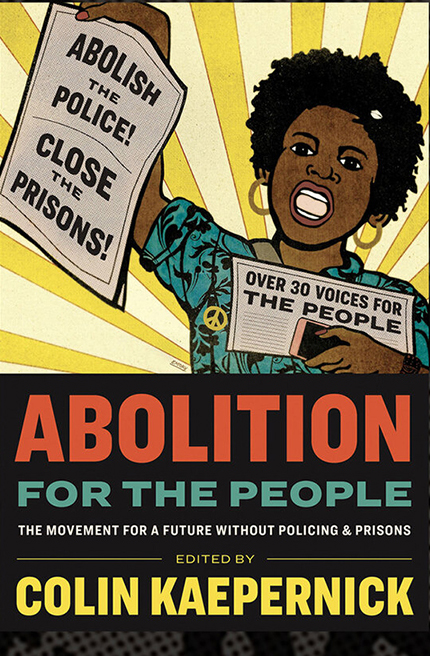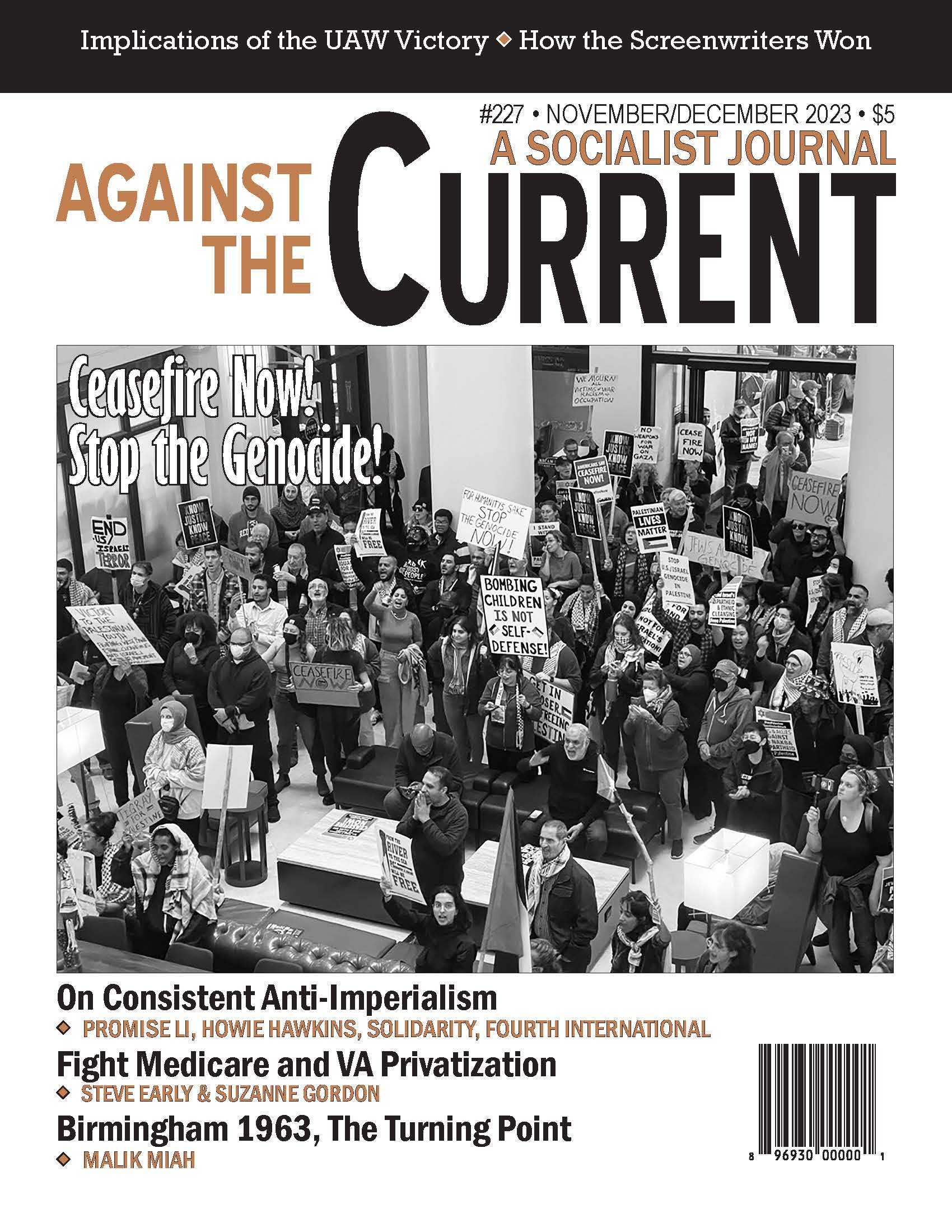Against the Current No. 227, November/December 2023
-
Auto: The Future on the Line
— The Editors -
Catastrophe in Palestine and Israel: Apartheid on the Road to Genocide
— David Finkel - Stand with Palestinian Workers
-
Parallel Fights Against Privatization
— Steve Early & Suzanne Gordon - Guatemala: Coup Instead of an Inauguration?
- New Labor
-
Strategies for Union Victories
— Dianne Feeley -
Writers Guild of America Wins
— Barry Eidlin interviews Alex O'Keefe & Howard A. Rodman - The Struggle for Self-Determination
-
Consistent Anti-Imperialism
— Solidarity -
Ukrainian Letter of Solidarity with Palestine
— Commons -- Ukraine -
On Imperialism Today
— Howie Hawkins -
In Solidarity with People's Struggles
— Fourth International -
Paths for Socialist Internationalism
— Promise Li - Reviews
-
The Testing of America: Birmingham 1963
— Malik Miah -
Echoes of Revolution
— Marc Becker -
The Making of Capitalism
— Mike McCallister -
Toward a "Transsexualized Marxism"
— M. Colleen McDaniel -
A Primer on Abolition
— Kristian Williams
Kristian Williams
Abolition for the People:
The Movement for a Future without Police & Prisons
edited by Colin Kaepernick
Kaepernick Publishing, 243 pages + endmatter, $27 paper.

ABOLITION IS AUDACIOUS. How could it not be?
In that spirit, on its very first page, the new collection Abolition for the People makes some striking promises:
“Abolition for the People draws on historical analysis, empirical data, and the firsthand accounts of survivors [of state and interpersonal violence] . . . to make a straightforward argument: Neither prisons nor police keep people safe, nor do they create the conditions necessary for communities to thrive. Abolition for the People further argues that efforts to reform police and prisons have nearly always enhanced their power, reach, and legitimacy. Simply stated, police and prisons . . . are death-making machines that run counter to harm reduction and the possibility of authentic human flourishing.” (13)
On the whole, the book delivers. Its 38 chapters include contributions from an impressive set of heavy-hitters: Angela Davis, Mumia Abu-Jamal, Kimberlé Crenshaw, Robin D.G. Kelley, Andrea Ritchie, Dylan Rodríguez, Dean Spade, and of course Colin Kaepernick, who served as the main editor.
(Kaepernick — I will explain for those like myself who throw away the sports page without looking at it — was essentially driven out of the NFL for kneeling during the national anthem in protest of police brutality and racial inequality. He is now more focused on writing and publishing.)
The book’s four sections examine the history and role of the police, and that of prisons, the limits of reform, and the possibilities for abolition. Many chapters focus on the experiences of particular groups of people — people of color, and African-Americans especially, but also queer and trans people, immigrants, students, people with disabilities, Indigenous peoples — emphasizing the ways the criminal legal system harms them and how the abolition of police and prisons would contribute to their collective liberation. Each critique also represents an angle of attack and identifies a potential constituency for an emerging movement.
The Abolitionists
In 2020, after the police murdered George Floyd in Minneapolis, many millions of people took to the streets. Some engaged in purely nonviolent protest, some in property destruction and looting, and some in direct combat with the police. They were, on the whole, acting as abolitionists, whether or not they had specifically abolitionist ideas in mind at the time.
Many millions of others watched this happening and struggled to make sense of it. Kaepernick’s collection would well serve either group, providing a range of ideas for understanding not only the momentous events of a few years ago, but the ongoing disaster that is the criminal legal system.
What Abolition for the People does well — and I think it does this exceptionally well — is to serve as a primer for those new to these ideas, either entering into activism or simply curious about demands to defund the police, abolish ICE, etc.
The chapters are very short, typically around seven pages. And, though the level of intellectual engagement is often very high, none of them make for difficult reading.
Each piece can stand on its own, and they all end with discussion questions. At the back of the volume, there is a glossary and a list of resources for further reading — or to get involved politically. The collection is perfectly suited for use in study groups, and one hopes that political organizations, groups of concerned citizens, and your mom’s book-and-wine club will make use of it in this manner.
Identity and Class
Most chapters center issues of identity, for good reason: the police predictably behave in ways that reinforce and preserve various kinds of status hierarchies, the structure of white supremacy foremost among them. Unfortunately, the foregrounding of identity means that capitalism becomes a background feature, a contextual element frequently acknowledged but rarely incorporated into an argument.
Capitalism is most present in Talila A. Lewis’s essay on disability justice, which counterposes abolitionist ideals with our present society’s presumption that a human being’s worth inheres her capacity for productive labor. More commonly, though, class is simply listed as one among many markers of identity. Given the anti-capitalist credentials of several of the contributors (most notably Angela Davis), I expect that this cursory treatment is simply a matter of emphasis necessitated by the brevity of the individual chapters.
However, as this emphasis is sustained in one chapter after another, it may leave a reader with the impression that class is a thing to be mentioned rather than studied, and that it is mainly a concern in the context of race politics (in understanding disputes between poor and middle-class Blacks, for example), as opposed to an exploitative social relation deserving destruction in its own right. This is a political as well as a theoretical shortcoming.
Although the collection clearly demonstrates that a number of particular groups have related but specific reasons for opposing the police and prisons, it does little to indicate why people outside of those identity categories might also be against the police, or why they should be. A class analysis could fill in part of this gap.
Prison and Poverty
Poverty is a major focus of police attention — from the criminalization of sex work and other sectors of the informal economy, to the persecution of the homeless, to the class-coded norms of “public order” and “quality of life” campaigns, the intimate connection between policing and public housing, the cooptation of social services in the name of “community policing,” the use of ICE to prevent immigrant workers from unionizing, and riot cops protecting scabs and attacking picket lines. When these dynamics appear in Kaepernick’s collection, they are generally described in terms of racism or other discrimination, rather than class and poverty.
What is worse, some contributors slip into speaking of race and class as though they inter-derivable, defining the “carceral class” (for example) as “persons of African descent who are systematically stigmatized as unfit for freedom and deserving of the dehumanization that comes with being incarcerated.” (This definition occurs three times, on pages 137, 141, and 288, and is identified as “a new term to the Black freedom lexicon.”) Though a recent Bureau of Justice Statistics report shows that Black people are an astonishing 4.5 times as likely to go to prison as white people, they constitute not quite a third of inmates (591,000 out of 1.8 million).
A greater number of those in jail and prison are white (658,000), and nearly as many (526,000) are of other races. That is quite a lot of people to exclude from the “carceral class,” and doing so leaves a potential ground for cross-racial solidarity largely untended.
One thing that nearly everyone in prison has in common, preceding their confinement, is poverty. Class cannot, of course, replace race in our understanding of the criminal legal system, or in our efforts toward abolition, but neither can we do without it.
Of course, no one book can do everything, and a call to broaden the abolitionist analysis is almost built in to this volume’s presentation, both as a challenge to readers and an invitation. The abolitionist project is necessarily expansive; it has to press ever further and reach into new and unexamined aspects of our society precisely because the institutions it seeks to abolish are themselves so expansive, so intrusive, so ubiquitous.
“Changing everything might sound daunting,” Mariame Kaba writes in the final chapter, “but it also means there are many places to start, infinite opportunities to collaborate, and endless imaginative interventions and experiments to create.” (242)
November-December 2023, ATC 276

